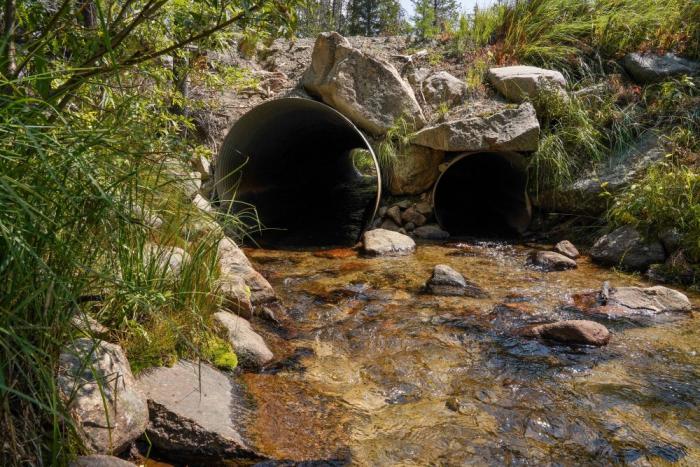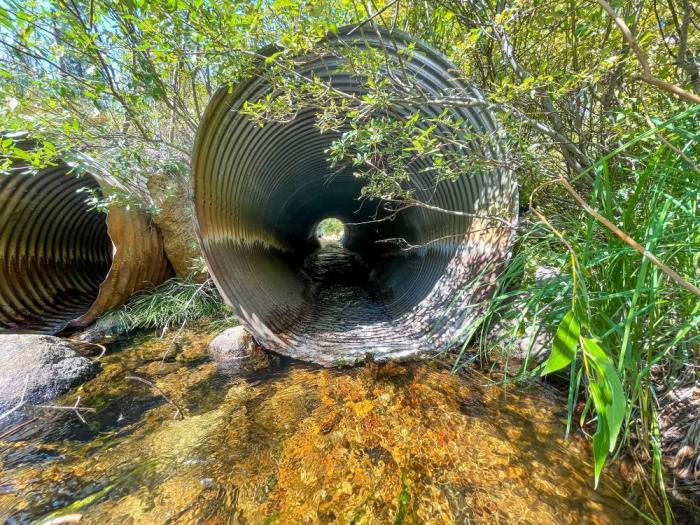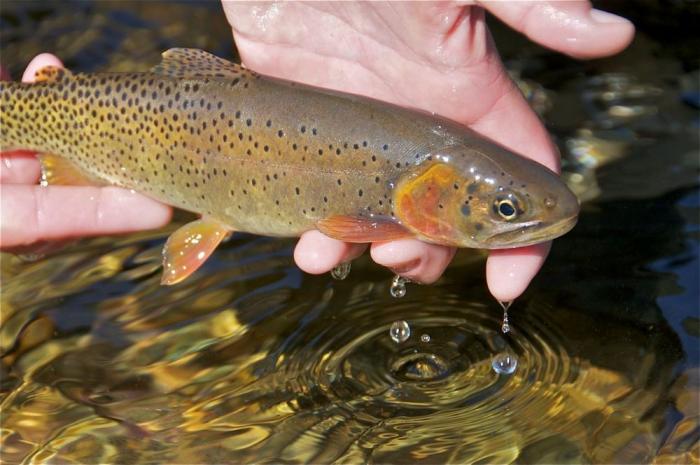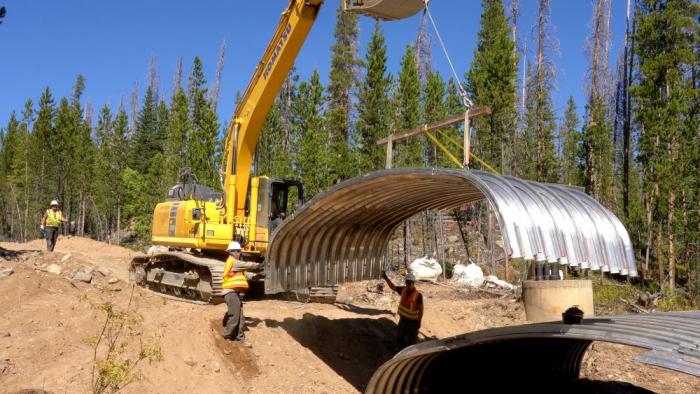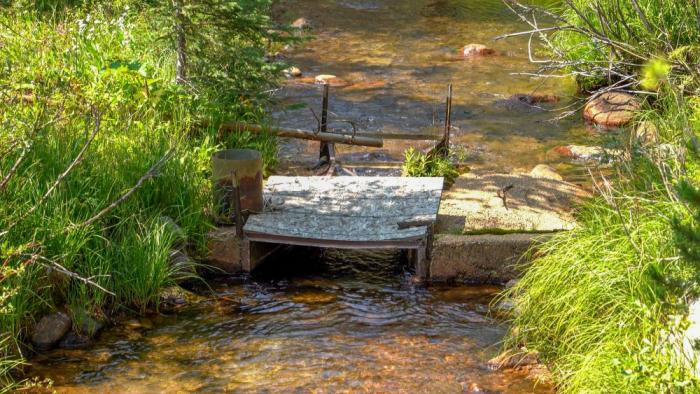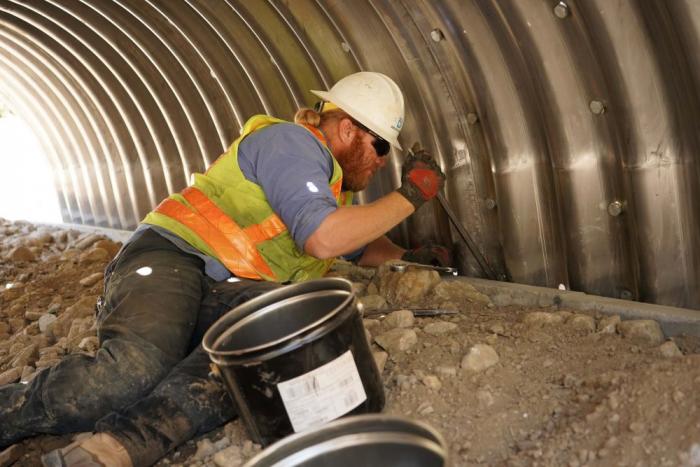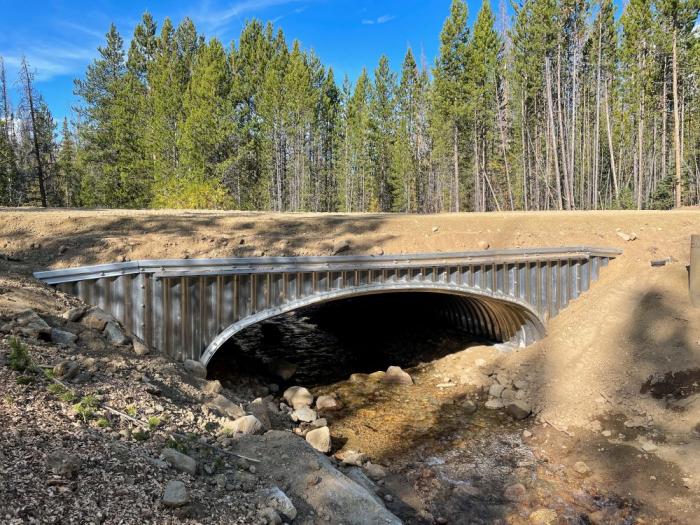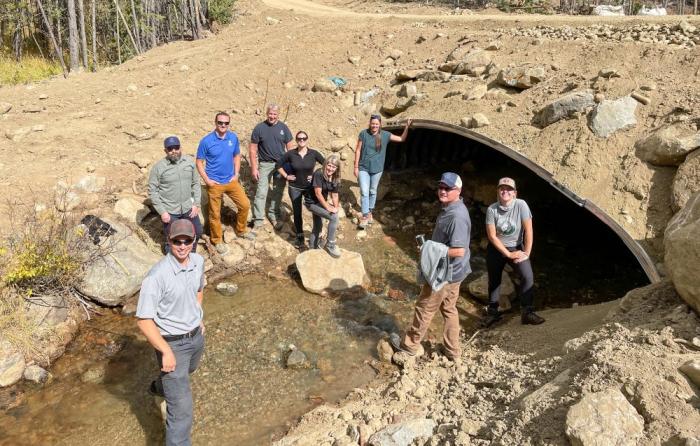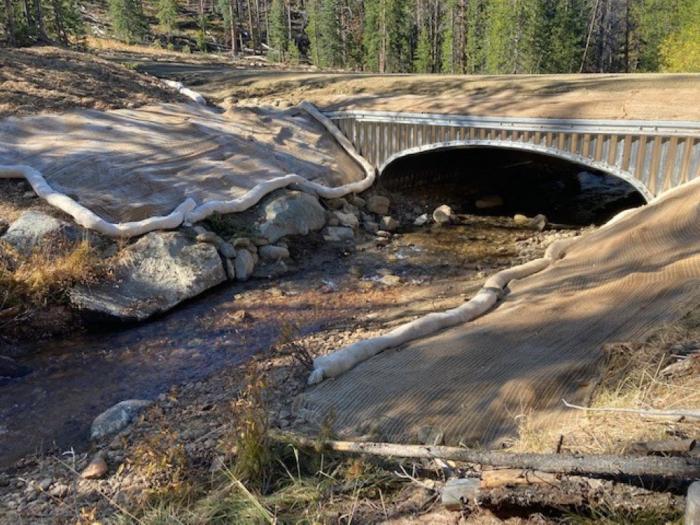Helping native cutthroat trout in Grand County
Scattered throughout America’s forests are thousands of old, tube-shaped metal culverts buried under mountain roads.
These culverts let a river or creek flow under a road, but they can make it difficult — and sometimes impossible — for fish and other aquatic organisms to move up and down a stream.
Two of those culverts were located on Cabin Creek northeast of Fraser in Grand County, Colorado and installed in the 1970s.
Recognizing the problem, Grand County Learning By Doing partners collaborated on a project to replace the two old culverts and installed a new culvert in the fall of 2021 that was specially designed to improve habitat for the Colorado River cutthroat trout that live in the stream.
Cabin Creek is a small mountain stream that flows through the Arapaho and Roosevelt National Forests. It drains into Ranch Creek, which then flows into the Fraser River, which eventually feeds into the Colorado River.
“The old culverts were designed to handle high flows of water to prevent roads from getting washed out, but they aren’t good for fish passage,” said Val Thompson, fisheries biologist with the Arapaho and Roosevelt National Forests. “The metal culverts act like a hose that increases the velocity of the water. Fish can get pulled through and then have a hard time swimming back upstream.”
Thompson said there are additional problems with old metal culverts in that they don’t have a natural streambed on the bottom. Another common issue is that the elevation of the ends of the tubes where the water flows in and out doesn’t always line up with the water level.
“There are some culverts that get perched, which creates a small waterfall at the end,” Thompson said. “Some larger fish might be able to make it through, but it’s very difficult for the juvenile fish to swim upstream through these old culverts.”
Healthy fish populations need to have full access to their streams to thrive, so barriers like the old culverts can threaten their survival. This is especially important for the Colorado River cutthroat trout, which is considered a “sensitive species” in the Arapaho and Roosevelt National Forests.
Sensitive species, identified by U.S. Forest Service regional foresters, are plants and animals for which there is a concern about their long-term sustainability.
Working together
The Cabin Creek culvert replacement project provided an opportunity for Learning By Doing partners, including Denver Water, the U.S. Fish and Wildlife Service, the U.S. Forest Service, Trout Unlimited and Grand County, to work together to improve fish habitat in the Fraser River Basin.
Learning By Doing is a unique partnership of East and West Slope water stakeholders in Colorado who work together on river health in Grand County.
“Rivers and streams here in Grand County have seen significant impacts over the years, and they need our help to improve the aquatic habitat,” said Anna Drexler-Dreis, coordinator for Learning By Doing. “The Cabin Creek project really shows what we can accomplish when the Learning By Doing partners work together.”
The project involved installing a special type of culvert called an aquatic organism passage, which fit in well with a U.S. Forest Service program that aims to improve road and stream crossings across the country.
The team effort required collaboration, cooperation and patience, according to Jason Marks, an environmental planner at Denver Water.
“As with most construction projects, there is more than meets the eye,” he said. “Learning By Doing secured grant money to fund the project, while the U.S. Forest Service handled authorizations and permits as well as the engineering and design plans. Denver Water contributed its construction crews, expertise and equipment.”
Trout Unlimited helped secure additional grant funding for the project and led the procurement process. Grand County and other Learning By Doing members provided review and input to the work planning and implementation process along the way.
The Cabin Creek Aquatic Organism Passage project was identified as part of an agreement between Denver Water and the Arapaho and Roosevelt National Forests to address issues on Colorado’s West Slope related to Denver Water’s historic water diversions in Grand County.
“This project came about during the many years Denver Water spent working with the U.S. Forest Service during the permitting process for the Gross Reservoir Expansion Project,” Marks said. “It’s one of several environmental improvement projects Denver Water agreed to do as part of the expansion project that are rooted in cooperation.”
Construction work
Denver Water has installed two other aquatic organism passage culverts in Grand County, so its crews are familiar with the unique nature of this type of construction process, compared to installing a traditional culvert.
“The Cabin Creek project involved removing the two original culverts, one 4 feet in diameter and the other one 3 feet, both made of corrugated steel,” said Tim Holinka, Moffat water collection system manager at Denver Water. “We also removed an old Parshall water measuring flume, which was acting as a fish barrier in the creek.”
Once the old culverts and flume were removed, Denver Water crews worked with U.S. Forest Service staff to install the new culvert that met their design specifications and replicated the natural stream as it passes under the road.
“Aquatic organism passages are like a bridge,” Thompson said. “They have a natural streambed on the bottom, so the water doesn’t travel through as fast compared to the older culverts. It’s much easier for the fish to go up and down the stream.”
The new culvert is strong enough to support large trucks and equipment while accommodating high stream flows during large rainstorms or during the spring snow runoff season.
By allowing the creek to flow over a natural bottom surface instead of through a metal cylinder, Denver Water crews were able to strategically place boulders and small rocks, called cobble, in specific locations of the streambed. The result is a structure that gives aquatic insects multiple places to live.
Another feature of the aquatic organism passage culverts is that there is room on both sides of the stream for other creatures, like toads, to easily move up and down the banks.
“These new structures really do make a difference for the fish and wildlife that live here,” Thompson said. “It’s critical that the fish are able to swim upstream to access as much of the stream as possible, so they don’t get separated from their population.”
“The benefit of Learning By Doing is all the cooperation between different groups. For Cabin Creek, we were able to get a lot of people around the table that were committed and focused on getting this project constructed in 2021,” Marks said. “We got funds, design and engineering, construction and permitting authorizations, all that had to happen precisely to make this happen.”
During construction, crews from the U.S. Forest Service caught and temporarily moved resident fish downstream of the project site. Thompson said the trout returned to the area once the project was completed in mid-October.
“I really love how everything turned out and it looks like a natural stream as it flows through,” Drexler-Dreis said. “It’s really a beautiful project that Learning By Doing was able to help out with.”


